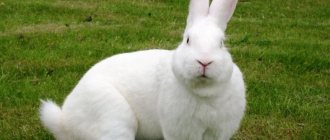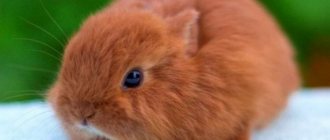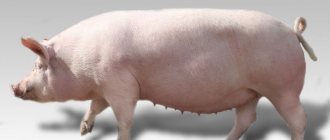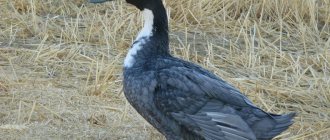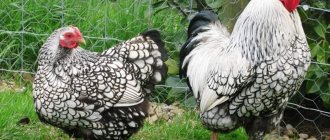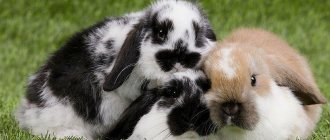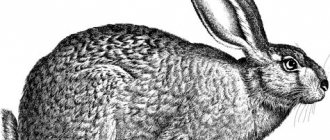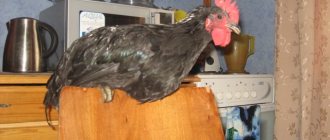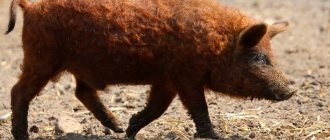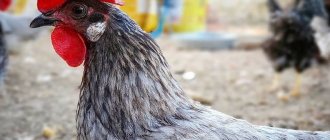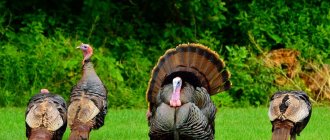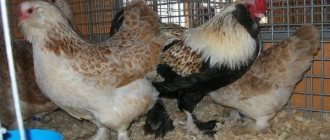When creating meat breeds of rabbits, the main attention is most often paid to increasing the maximum weight of adult individuals or their precocity. The Vienna Blue rabbit in this regard differs from its counterparts, because when breeding this breed, breeders sought to make its representatives not only “professionally suitable” in terms of meat and skin characteristics, but also beautiful.
The Vienna Blue rabbit (pictured) combines high quality meat and fur
Let's look at the most significant characteristics of the breed in the table:
| Parameter | Characteristic |
| Animal | Rabbit (Oryctolagus cuniculus L) |
| Breed | Vienna blue |
| Productive type | Meat skin |
| Live weight of an adult | 4.5-5.5 kg (maximum up to 7 kg) |
| Body length | 52-56 cm |
| Bust | Average 38 cm |
| Ear length | 12-15 cm |
| Fur color | Gray-blue (steel with a blue tint); varieties with monochromatic black and white colors have been bred |
| Age of puberty | About 4-5 months; Females older than 7 months are allowed to mate |
| Multiple pregnancy | 7-9 cubs per litter |
| Age at slaughter weight 2.5-3 kg | 4 months |
| Killer exit | Up to 60% |
| Quality of skin and fur | Very high |
| Sustainability | Well adapted to unfavorable climatic conditions; slightly susceptible to common infectious diseases |
| Year of registration in the State Register of the Russian Federation | 1993 |
| Regions recommended for cultivation | All regions of Russia |
| Originators | Livestock Breeding LLC (Perm), Plemzverosovkhoz Saltykovsky OJSC (Moscow region) |
History of the breed
The author of the breed is considered to be the Austrian breeder Johann Konstantin Schulz. It took the scientist two years to obtain a new variety, during which he crossed several individuals of Flanders and Moravian rabbits and selected new specimens.
In 1897, a beautiful rabbit called the Vienna Blue Giant appeared at the Vienna Prater Animal Exhibition. This specimen actually weighed more than seven kilograms.
But further research showed that for the purpose of farm breeding, fattening an animal to such a weight is unprofitable. Therefore, the breed was adjusted and received the final name Vienna Blue. In addition to tasty meat, it is famous for its high-quality fur, high fertility of females, and unpretentiousness. Then the breed began its victorious march across Europe, and in the 30s of the last century it appeared in Russia.
Soviet rabbit breeders were interested in the breed, and it was acclimatized to the conditions of our country. At the same time, the weight of the individuals increased slightly, and the quality and size of the skin also increased.
Photo gallery of the Viennese Blue breed:
Literature
- Zhitnikova Yu. Zh.
“Rabbits: breeds, breeding, maintenance, care.” - Rostov n/d: “Phoenix”, 2004. - 256 p. - (Compound). — 75,000 copies. — ISBN 5-222-05603-1. - Gorbunov Viktor Vladimirovich.
"Rabbits: breeding, keeping, care." - M.: "Astrel", 2012. - 260, ill. With. - (Compound). — ISBN 978-5-17-072558-8. - Aleksandrov S. N., Kosova T. I.
“Rabbits: Breeding, rearing, feeding.” - M.: "Astrel", 2010. - 180, ill. With. — ISBN 978-5-17-059937-0. - Vagin E. A., Tsvetkova R. P.
“Rabbit breeding on private farms” / Ed. Balakireva N. A.. - M.: Moskovsky Rabochiy, 1981. - 160 p. — 75,000 copies. — ISBN 5-7545-0579-5.
Mr. Tail recommends: description and standard
There are several standards for the Vienna Blue breed in the world, but there is no single international standard. Here are the characteristics and description of the Russian version:
- Head. Massive, with a wide forehead and large cheeks.
- Eyes. Large, slightly convex, widely spaced. Color - black or brown. Albinos have only bright blue ones.
- Ears. Standing, quite long (13-16 cm).
- Neck. Short, almost invisible.
- Body. Medium size (57-58 cm), chest girth 37-38 cm. Congestion index (body density) 60-64%, which determines the mesosomal type of build.
- Paws. Straight, strong and strong. The front ones are much shorter than the rear ones.
- Fur. Short, dense, shiny, evenly colored, the undercoat is slightly lighter than the main hair.
- Color. Dense blue, sometimes bluish with a metallic tint.
- Weight. The body weight of an animal ready for slaughter is 3.5-5.4 kg.
- Fertility. Average. The number of rabbits in a litter is from 6 to 9.
- Precocity. High. By the age of 3 months, the rabbit’s weight reaches 3.5 kg.
- Good yield. Average - 58-59%.
For other countries, weight indicators are slightly different. France 3.6-4.5 kg; Germany - 3-4 kg, Denmark - 4.6 kg. For the albino species they are different. France - 2.7-3.6 kg, Germany - 3-4 kg, Denmark - 3.8 kg.
The tightness index is determined by finding the percentage ratio of chest circumference to body length. According to this parameter, the types of rabbits are divided:
- mesosomal (medium elongated) - 60-64%;
- leptosomal (long-extended) - up to 60%;
- erysomal (short-bodied) - more than 64%.
Based on this index, we can talk about the quality of the skin. The Vienna Blue's fur quality is considered slightly above average.
It is also assessed by the thickness of its fur. To do this, determine how many hairs are located on one square centimeter of skin.
For comparison, the following data is provided:
- Vienna blue - 21 cm²;
- Black and white - 24 cm²;
- Soviet chinchilla - 23 cm²;
- White giant - 19.2 cm²;
- Giant gray -16 cm²;
- Angora - 12-13 cm²;
- Rex, German ram - 24-25 cm².
That is, in terms of the quality of fur, the Viennese rabbit is only slightly inferior to the Rex rabbits with their velor velvet dense fur.
For successful breeding of meat and skin breeds, the character of the animals is also important. Thus, very calm, even phlegmatic varieties are considered the best; they are less susceptible to stress.
The Vienna Blue is quite complex in this regard, as it is overly impulsive and sometimes aggressive when mated. Therefore, novice rabbit breeders are not recommended to start with this breed.
Appearance of purebred Viennese blue rabbits
Viennese blue rabbits have a strong constitution and harmonious physique. The coat is smooth and thick, has a glossy sheen. The spine and underfur are usually evenly colored, with the hair at the base being lighter. Down hairs are much lighter than guard hairs and are present in large quantities in Viennese rabbits.
Rabbits are born with gray fur, which after the second molt takes on a dove-blue color. In summer, a brown tint may appear, which disappears as winter approaches. The head of rabbits is light, the ears are set straight, their average size varies from 13 to 16 cm. The body is compact, dense, its maximum length is 60 cm. The chest is wide and deep (about 38 cm in girth), and rabbits have a pronounced dewlap. The limbs are straight, fairly strong and muscular. The back is wide, elongated, the croup and lumbosacral part are rounded and wide. Vienna rabbits have bluish claws and dark blue eyes.
Possible disadvantages in appearance of non-pure breed rabbits :
- weight less than 3.5 kg;
- insufficiently harmonious physique;
- minor changes in the color of eyes, claws and fur;
- decreased glossiness of fur and insufficient hair length.
Signs of breed quality and its value
The criteria for determining the thoroughbred component include the following:
- Body: high density, up to 57 cm long, well-developed muscles, wide chest and back.
- Ears: length 13-15 cm, rounded.
- Eyes: dark blue to blue.
- Limbs: strong, straight, with sharp claws.
- Weight: 4-5 kg. Specimens weighing up to 7 kg are rarely found.
- Hair: uniform, bluish-gray, without other color inclusions, fur density 20-21 thousand hairs per 1 square meter. cm skin.
The value of a breed is determined not only by the speed of ripening and meat production. The main direction is the use of Vienna Blue rabbit skins in industry to imitate valuable furs.
Productive characteristics of the breed
Central Russia has the most suitable climate for growing Vienna blues. The development and reproduction of this breed is also possible in cold regions.
Under favorable conditions, animals are quite precocious. So, at the age of 2 months, the weight of a rabbit can reach 1.6 kg, at 3 months up to 2.5 kg, and at 16-18 weeks the Vienna Blue weighs up to 3.6 kg.
Females bring up to 10 gray rabbits per litter, weighing up to 75 g each. The female rabbit is a responsible dairy mother, so the survival rate of babies is high, even in cold climates.
Mostly blue rabbits live up to 7-7.5 years, but there are cases when animals lived up to 12 years.
Temperament
Vienna Blues are the most suitable eared dogs for keeping at home and subsequent breeding. Rabbits are absolutely not aggressive, they are calm and express friendliness. They are shy and curious. They are suitable for training, quickly getting used to a person and becoming tame.
However, under unfavorable conditions of detention, negative actions on the part of a person can be responded to with aggression.
If such a rabbit is purchased for decorative use, it should be borne in mind that as it grows, the amount of feed the animal needs will increase, and its thick coat must be looked after.
Varieties
Initially, only one color of the Viennese rabbit was recognized, namely blue. But over time, rabbit breeders began to believe that other colors had a right to exist.
Viennese albino
No different from the Viennese standard color, only with a snow-white coat and eyes of an amazing cornflower blue color. This albino never has red eyes.
The variety was obtained by the famous breeder Wilhelm Muk by hybridizing two breeds - the standard Viennese blue and the Dutch blue-eyed.
These animals are so beautiful that recently they are increasingly kept at home as decorative pets.
Black Vienna
This variety has an amazingly beautiful coat - anthracite-glossy, thick. And the weight of adults is even slightly higher than that of a standard blue rabbit. Obtained by crossing the original color with the Alaska rabbit.
How to choose a good healthy individual?
When choosing an individual, feel free to inspect the entire animal.
Focus your inspection on the following details:
- A healthy rabbit is active, jumping, its tail pointing up.
- A healthy rabbit's back is rounded. Humps and dips are a sign of disease.
- A head turned to the side or tilted to one side indicates problems with cerebral circulation.
- Check your bite. Normally, the upper teeth overlap the lower teeth.
- The eyes of a healthy animal are clean, shiny and have a clear look.
- The condition of the coat must be perfect.
Ask the seller about the pedigree and genetic abnormalities, check whether vaccinations have been carried out, what diseases the animal has suffered and the use of what medications cured it. Ask about what your pet especially likes from food.
Care and maintenance
Viennese blue rabbits do not have any difficulties in daily care and maintenance. The main requirements must be met:
- Prevent drafts. To do this, cages, enclosures, and sheds should be positioned correctly.
- Protect from direct sunlight. This is also influenced by the location of the rabbits’ dwellings and their equipment with reliable canopies.
- Maintain a high sanitary and hygienic level, which should be facilitated by a cage design that makes them easy to clean. It is also important to regularly change the hay mats.
- Monitor the health of pets and prevent outbreaks of infections. To do this, the cages must be clearly visible so that the farmer can see all the animals.
- Feed nutritiously, which will help prevent diseases in the livestock and give individuals the opportunity to quickly gain weight.
Also, when keeping Viennese blue rabbits, it is important to remember that these animals are very energetic, so drinkers and feeders in cages should be arranged in such a way that they cannot be overturned and broken. The best option would be nipple, vacuum, and bunker systems.
If rabbits are outdoors, then for the winter period it is necessary to provide either insulation of the cages or their reconstruction indoors.
In addition, these rabbits are so temperamental and touchy that they can bite a person if they don’t like something. Therefore, it is important when keeping this breed to never raise your voice near enclosures, to behave calmly and friendly with your pets, and not to frighten them.
You should not keep Viennese Blues in pits. The skin of this breed is no less valuable than the meat, and in such conditions it will suffer and the quality of the fur will decline.
Of all the housing methods, the most optimal is the shad one, when all animals are under a common canopy and are well protected from bad weather, heat and drafts.
Reviews from rabbit breeders
At one time I dealt with Viennese rabbits. I can't say anything bad about them. The meat yield, of course, is not the greatest (there are more productive ones in this regard), but, at the same time, it is far from the worst option. Especially for beginning farmers. These rabbits need to be fed a variety of foods, but they eat very little. The skin is very good, which is a definite advantage. By the way, during the years that we bred rabbits of this breed, they practically did not get sick. Ekaterina, 60 years old, Volgograd
Viennese blue rabbits or simply Austrians are a kind of golden mean among meat-skin breeds. They are not leaders in most characteristics important for slaughter animals (perhaps, except for fur), but by 5 months they gain more than 4 kg, of which the meat yield is at least 2.5. It takes very little resources to grow and fatten, and there are practically no problems with maintenance. Inna, 39 years old, Krasnodar
This breed is well suited for farmers who are just learning to raise rabbits. They are completely undemanding when it comes to food and care, they can live outside all year round (if the winter is not too severe), and they consume relatively little food. The skin of Viennese rabbits cannot be confused with any other rabbits; the fur is very thick and impresses with its beauty. Valery, 51 years old, Blagoveshchensk
Feeding
Vienna Blues, like all breeds, are herbivores. They constantly chew grass and hay.
If rabbits begin to eat feces, then the farmer is faced with the phenomenon of caecotophoria. There is nothing wrong with this, this is an evolutionary adaptation mechanism that arose in the wild to replenish certain minerals in the bodies of animals and corresponds to the repeated digestion of grass in ruminant species.
In order to increase the yield and quickly fatten Viennese rabbits, it is necessary to correctly prepare their diet. It should contain the following types of feed:
- rude;
- juicy;
- green;
- concentrated;
- vitamin supplements and minerals.
The best choice of herbs would be to include lupine, oats, winter rye, clover, vetch, alfalfa, corn, peas and others.
Coarse ones must contain straw from grain crops, meadow and steppe herbs in the form of hay, branches and bark of maple, acacia, linden, willow, willow, and coniferous trees.
In small quantities, juicy additives are introduced into the diet in the form of chopped fruits (apples) and vegetables (zucchini, pumpkin, carrots, cabbage), and silage.
In winter, feed, bran, cake, fish and meat and bone meal, acorns, whey, and milk are added.
Character
The Viennese rabbit, in this sense, is a difficult breed and is not very suitable for beginners. Strong, powerful Viennese rabbits do not tolerate unceremonious handling. If they sense weakness in the actions of the nursing staff, they may be injured.
Did you know? According to research, rabbit eyes can only distinguish two colors - red and green.
The main qualities of eared cats are friendliness, playfulness and curiosity. They are interested in everything, they will be happy to explore new territory.
Quite often these animals get offended. A rude attitude towards rabbits is unacceptable, since upon hearing sharp cries or feeling an indifferent attitude, they often withdraw into themselves, begin to show aggression and get scared.
Breeding
There is nothing difficult about breeding Viennese blue rabbits. Individuals mature early, at 5-8 months, with females earlier than males.
For a female rabbit during pregnancy, it is necessary to organize mating on the male’s territory and repeat it after 5-7 days.
The only thing is that you should be very attentive to the behavior of animals at this moment. Sometimes rabbits behave so impulsively that they can severely bite a rabbit and even a person if they try to protect her.
The gestation period is short - from 28 to 32 days. The female must be immediately placed in a cage with a queen cell. She will begin to prepare the nest - dragging straw and hay there, mixing them with the fluff plucked from the chest.
Viennese rabbits often give birth early in the morning and quickly - within 10-50 minutes. Human assistance is usually not required.
Female Viennese blue rabbits have proven themselves to be excellent and caring mothers. They always have a lot of milk, they never eat children, and they carefully look after them. At the same time, they instantly recover after childbirth and within a day they are ready for a new mating.
Winter cubs have a high survival rate even in unfavorable weather conditions and severe frosts.
Newborn Vienna rabbits weigh 65-70 g, and by 2 months they already exceed 1.5 kg. At 28-30 days, the cubs begin to be vaccinated, having previously undergone deworming.
Young animals intended for fattening are removed from their mother at 2 months and separated by gender to prevent spontaneous mating.
It is believed that the most cost-effective would be to slaughter by 5 months, and the best quality of skins is in the autumn and winter.
Based on the combination of a number of characteristics (precocity, fertility, quality of meat and skins, unpretentiousness), this breed is considered one of the best for private and industrial farming.
Productivity
Vienna rabbits are rightfully considered a worthy breed for meat production. They are distinguished by active growth and rapid weight gain, with a slaughter yield of 55-60%. By following all the rules for feeding and keeping these animals, the farmer can count on the following indicators:
| Age (months) | Live weight (kg) |
| 2 | 1,5 |
| 3 | 2,5 |
| 4 | 3,2 |
| 4,5 | 3,7 |
The fertility of the “Austrians” allows farmers to significantly increase their livestock in one litter
Female rabbits are quite fertile and have good milk production - in one litter the female usually brings 7-9 babies and successfully feeds them. Note that newborn rabbits and young animals have very decent survival rates, including in the cold season.
Health and prevention
Viennese blue rabbits are distinguished by high immunity and good health. But to prevent the loss of livestock, it is necessary to strictly adhere to the deworming schedules and vaccination schedules against myxomatosis, VHD, and rabies.
A number of possible diseases affecting the gastrointestinal tract will be helped by maintaining a high sanitary and hygienic level of keeping rabbits and regular cleaning and disinfection of cages.
The only thing you have to fight is pododermatitis, the formation of peculiar corns and ulcers on the paws. This pathology occurs, as in all heavy breeds, from the animal sitting for a long time on a slatted or hard floor. Frequently replacing the hay can help here.
Possible diseases
To prevent diseases and epidemics, in addition to being kept in hygienic conditions and nutritious food, rabbits are vaccinated.
Vaccinations against viral infections, for example, viral hemorrhagic disease of rabbits, and myxomatosis, are especially relevant. The first vaccination is given at 1.5 months, the next at 3 months. Then the animals are vaccinated once a year.
If the Viennese Blue Rabbit lives as a pet, it is necessary to vaccinate against rabies.
Acquisition
For fattening, young animals are purchased starting from one month of animal life, and for breeding - at 3-4 months.
Most often, the acquisition of a couple for a tribe is accompanied by the receipt of the following documents:
- Veterinary certificate on the health status of animals (F1).
- Veterinary certificate (F4).
- Registration certificate for breeding animal.
- Veterinary passport.
These documents are issued only to those individuals who have been fully vaccinated against myxomatosis, rabies, and VGCH.
Before buying Viennese blue rabbits, you need to make sure that they are healthy, that is, they have shiny fur, clean eyes, nose and genitals.
For purebred animals purchased for breeding, the bite, color and condition of the eyes, ear size, paw length, and compliance of other breed qualities with the standard are also checked.
The cost of these rabbits is quite high. Juveniles for fattening are sold for 700-800 rubles per kilogram of live weight, and breeding individuals can cost from 3500-5000 (rabbits) to 5000-8000 (female rabbits).
Reproduction
When breeding rabbits, it is important to be able to select individuals that will be slaughtered, i.e. need fattening, and individuals intended for further reproduction.
This selection takes place in three stages:
- The first stage is when the rabbits are deposited from the female, from 28 to 60 days from birth.
- The second stage is at the age of 3 months.
- The third stage is at the age of about 5 months, upon the onset of puberty.
It is important to ensure that parental pairs are not formed from individuals of the same litter. Otherwise, the offspring will be weak, and the breed will begin to degenerate.
Criteria for selecting a parent couple:
- perfect health;
- absence of congenital defects and respectable appearance;
- development appropriate to the breed;
- well-developed mammary glands in females.
Animals no younger than 7 months are allowed to mate, although sexual maturity occurs much earlier.
If the birth rate is good, the pair can be preserved for 5 years.
If the litter is infertile or the female abandons the cubs, eats them, etc., try to disband the pair, changing partners, or select a new one from the remontant individuals.
Gestation of offspring takes up to 35 days, feeding them takes no more than 2 months, and it is possible to separate the young from the mother as early as a month after birth. Do not allow more than 5 births in a year, so as not to cause irreparable harm to the health of the rabbit.
Advantages and disadvantages
This breed is one of the most promising for breeding in our country, as it has been acclimatized and has a number of advantages:
- high fertility and early maturity;
- fairly good indicators of fur quality;
- tasty meat with good yield;
- good immunity;
- the need for a small amount of feed;
- good adaptability to climatic conditions and unpretentiousness to living conditions.
The only drawback of Viennese blue rabbits is their high susceptibility to stress and, as a result, some aggressiveness, especially during the mating season.
Price
To propagate the breed, you should purchase at least one pair of rabbits. The female and male must be from different parents.
It is optimal to buy 2 rabbits and one rabbit at once. When purchasing, pay attention to appearance, behavior and pedigree.
To use as a pet, you can purchase an individual of any gender. Be sure to check your vaccinations.
You can purchase Viennese Blues through online stores or by personally visiting rabbit farms, from amateur breeders, etc. Moreover, if such a breed is not in the price list, it is possible to deliver individuals from Europe.
The cost of one animal ranges from 800 to 2000 rubles.
A positive example of compacted litters
It has been experimentally proven during broiler fattening on automated farms that the best time for insemination of Vienna Blue rabbits is in the first two days after birth. It turned out that early and very early insemination does not lead to a decrease in the number of rabbits born. This effect is observed within 2-3 births.
The first birth of young rabbits is the least fruitful, the peak is on the second or third birth.
With broiler fattening, due to the rapid rotation of the breeding stock, extra-early litters are justified. Let me remind you that female rabbits can come into heat on the first day after giving birth. Look at the peculiarities of the genital sphere of rabbits, the reproduction of rabbits.
